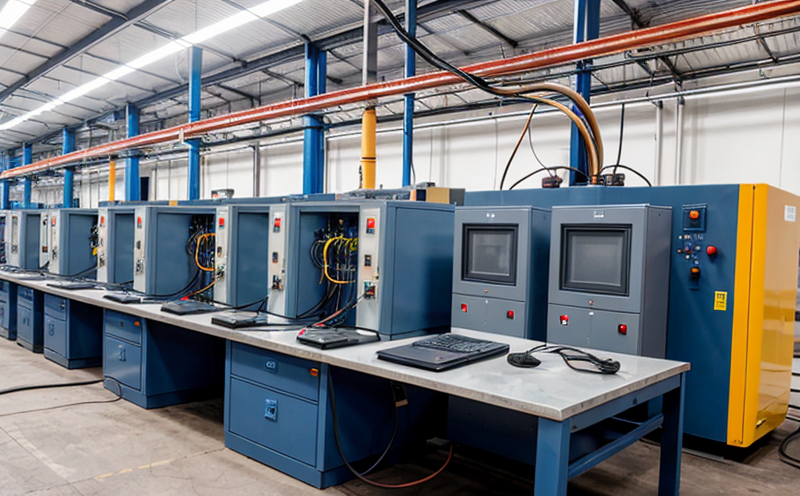IEC 61511 Process Industry Control System Safety Testing
The IEC 61511 standard is pivotal in ensuring the safety of control systems used in process industries. This international standard provides a framework for engineering and maintaining safety instrumented systems (SIS) to prevent catastrophic failures that could lead to accidents, environmental damage, or financial losses.
Process industries, such as oil refining, chemical processing, and power generation, rely heavily on complex control systems to manage their operations. These systems are responsible for monitoring, controlling, and protecting the process from anomalies that might compromise safety. IEC 61511 ensures that these systems adhere to stringent safety requirements, making it an essential standard in the industrial manufacturing sector.
The standard focuses on risk assessment, system integrity management, and lifecycle maintenance of SIS. It provides a structured approach to identifying hazards, assessing risks, selecting appropriate safety measures, and implementing these measures through a systematic process. This ensures that control systems are not only functional but also safe under all operating conditions.
Compliance with IEC 61511 is crucial for several reasons. First, it helps organizations meet regulatory requirements set by various national and international standards bodies. Second, it enhances the reliability of safety-critical processes, reducing the likelihood of catastrophic events. Third, it supports continuous improvement in safety practices, fostering a culture of risk awareness and proactive management.
The testing process under IEC 61511 involves several key steps. Initially, a detailed risk assessment is conducted to identify potential hazards within the control system. This step is critical as it forms the foundation for all subsequent activities. Next, the identified risks are quantified, and appropriate safety measures are selected based on this analysis.
The selection of safety measures typically involves specifying Safety Instrumented Functions (SIFs) and their associated instrumentation. These SIFs must meet stringent criteria to ensure they can reliably detect and mitigate potential hazards. Once the SIFs are defined, they need to be rigorously tested to validate their performance under various operating conditions.
The testing process itself involves a range of techniques tailored to the specific requirements of IEC 61511. This includes functional safety tests, diagnostic coverage checks, and other relevant evaluations. The use of advanced instrumentation such as programmable logic controllers (PLCs), distributed control systems (DCSs), and supervisory control and data acquisition (SCADA) systems is essential for conducting these tests accurately.
After the testing phase, a comprehensive report detailing the results and findings is prepared. This report serves multiple purposes: it provides evidence of compliance with IEC 61511, offers insights into system performance, and highlights areas for improvement. Regular audits and retesting are also recommended to ensure ongoing adherence to safety standards.
The importance of IEC 61511 cannot be overstated in the context of industrial manufacturing and processing testing. By adhering to this standard, organizations can enhance their safety measures, comply with regulatory requirements, and maintain a robust system that is resilient against potential failures.
Why It Matters
The implementation of IEC 61511 is vital for several reasons. First, it ensures compliance with international standards, which is essential for global operations. Second, it enhances the reliability and safety of control systems, reducing the risk of catastrophic events. Third, it supports continuous improvement in safety practices, fostering a culture of proactive management.
Compliance with IEC 61511 not only protects personnel but also safeguards the environment from potential hazards such as fires, explosions, and chemical leaks. By adhering to this standard, organizations can minimize environmental impact and ensure sustainable operations.
The standard’s emphasis on lifecycle management of SIS ensures that systems are maintained and updated throughout their operational life. This proactive approach helps in identifying and addressing potential issues before they escalate into major incidents.
Moreover, IEC 61511 fosters collaboration between different stakeholders involved in the design and operation of control systems. This collaborative approach leads to more effective risk management practices and better decision-making processes.
In summary, adherence to IEC 61511 is crucial for enhancing safety, compliance, reliability, and sustainability in industrial manufacturing and processing operations.
Industry Applications
- Oil Refining: Ensuring the safe operation of complex refining processes.
- Chemical Processing: Managing hazardous chemicals safely through robust control systems.
- Petrochemical Plants: Implementing safety measures to prevent explosions and fires.
- Pharmaceutical Manufacturing: Protecting sensitive products from contamination and ensuring worker safety.
- Power Generation: Maintaining stable power supply while managing the risks associated with thermal processes.
In each of these applications, IEC 61511 plays a critical role in establishing and maintaining safe control systems that are capable of handling complex operational environments.
Use Cases and Application Examples
- Oil Refining: Testing the SIS used to manage the refining process, ensuring it can detect and mitigate potential hazards like overheating or pressure surges.
- Chemical Processing: Evaluating the safety of control systems in environments where hazardous chemicals are processed. This includes testing for diagnostic coverage and functional safety under various operating conditions.
- Petrochemical Plants: Implementing a systematic approach to risk assessment, system design, and lifecycle management. This ensures that SIS can effectively prevent accidents such as explosions or leaks.
- Pharmaceutical Manufacturing: Ensuring the safety of control systems in environments where contamination must be strictly controlled. This involves rigorous testing of SIFs and their associated instrumentation.
- Power Generation: Testing the SIS used to manage thermal processes, ensuring they can handle high-pressure steam or gas safely.
These use cases illustrate how IEC 61511 is applied across various industries to ensure safety and reliability in control systems.





